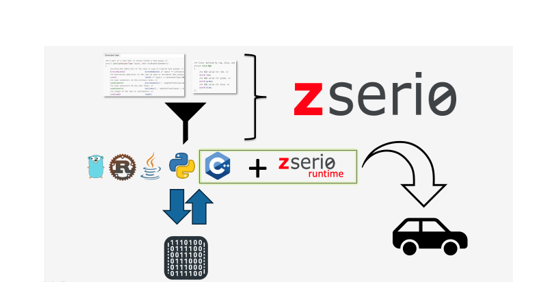Let’s be honest: we all want to become faster, more efficient and better, don’t we? This is exactly what open-source software addresses with its promise to accelerate automotive innovations while streamlining development processes and reducing costs. The problem: Open-Source Software (OSS) can sometimes lack functional safety aspects, especially when it is used in critical systems like automated driving. Functional safety refers to the software’s ability to operate without causing any unacceptable risk of physical injury or damage. Meeting these standards in open-source projects presents unique challenges.
At this year’s ELIV Conference, Fabian Klebert, CEO at Klebert Engineering and NDS Technical Lead, addressed this important topic, concentrating on the areas of “Functional Safety and Open Source in NDS” and zserio.
The ELIV Conference (Electronics In Vehicles) is a prominent industry event held in Germany, primarily focused on the latest developments and innovations in automotive electronics and software. Organized by the VDE Association for Electrical, Electronic and Information Technologies, it gathers automotive manufacturers, suppliers, and technology providers from around the world. ELIV serves as a platform for discussing and showcasing advancements in vehicle electronics, with a strong emphasis on emerging technologies, regulatory changes, and new solutions in the field of automotive electronics.

Open-Source Software (OSS) often lacks functional safety requirements because it’s often developed without the rigorous testing, certification, and documentation required for safety-critical applications. This topic is also relevant for the members of the NDS Association, because security and reliability play an essential role in the automotive environment, not only on the road or in the car, but also in the handling of data and information.
NDS standardizes map format for HD maps and other maps relevant to navigation and modern mobility. NDS members and experts jointly develop tools like Map Viewer and software components for serialization and deserialization like zserio.
Today, map data in the NDS format is used in millions of vehicles of over
40 automotive brands globally, including L2+ and L3 automation systems. Functional safety plays an essential role, particularly in the area of L3 automated driving.
What is zserio all about?
zserio is an open-source, high-performance serialization framework and interface definition language (IDL) designed to produce efficient code across multiple programming languages based on specified data structures.
NDS has chosen zserio over other serialization mechanisms (e.g. Protocol Buffers) because it is faster, it allows more advanced schemas, it is ASIL-ready. Companies outside the navigation sector are also increasingly interested in zserio as a serialization format.

How zserio supports functional safety
zserio supports functional safety in several ways, making it suitable for use in safety-critical applications:

How NDS got zserio into a L3 system
Through this approach, one NDS member successfully integrated zserio into their L3 system, ensuring it met the critical safety and functional requirements needed for deployment.
Fabian Klebert explains: “More OEMs and Tier 1 suppliers (NDS members) are now implementing safety-relevant systems with zserio, despite having slightly different requirements and using various static code analysis tools with differing sets of checks.”
In his Audience Choice Award-winning presentation at this year’s ELIV Conference, Fabian delivered a compelling message to the automotive industry: “If you want open-source software in safety-critical systems, the industry must align on a unified set of tools and processes that OSS developers can follow. Make it easy and appealing to earn a functional safety badge for your code – perhaps even consider offering it as a free SaaS solution. It’s time to come together and establish one standardized approach for the open-source community to follow when addressing functional safety in automotive systems.”
Best Practice for OSS developers
Klebert has compiled the following tips for OSS developers:
zserio: What’s next?
NDS will officially hand over zserio to the Eclipse Foundation SDV, marking an important step in the framework’s continued development. While the ownership will be with the Eclipse Foundation, NDS remains the maintainer of the project, continuing to fund development and provide essential support to NDS members with urgent hotfixes and other critical updates.
This move also allows NDS to benefit from the industry-wide efforts aimed at improving functional safety requirements for open-source software, ensuring that zserio stays aligned with evolving safety standards.
Additionally, NDS is committed to sharing its experience gained throughout the process to help further the development of functional safety in the open-source ecosystem.
To learn more about NDS.Live, please visit the NDS.Live Developer Portal.
Back to news →